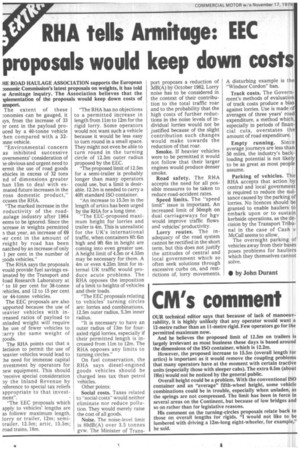RHA tells Armitage: EEC proposals would keep down costs
Page 26

If you've noticed an error in this article please click here to report it so we can fix it.
HE ROAD HAULAGE ASSOCIATION supports the European :onornic Commission's latest proposals on weights, it has told ie Armitage inquiry. The Association believes that the lplementation of the proposals would keep down costs of ansport.
The extent of these 2onomies can be gauged, it tys, from the increase of 33 ar cent in the payload prouced by a 40-tonne vehicle 'hen compared with a 32nine vehicle. "Environmental concern as inhibited successive overnments' consideration of le obvious and urgent need to ermit the use of road goods ehicles in excess of 32 tons nd of dimensions greater han 15m to deal with esmated future increases in the ross domestic product," ccuses the RHA.
"The marked increase in the roductivity of the roadaulage industry after 1964 eems to be ignored. Since the acrease in weights permitted a that year, an increase of 69 ler cent in the amount of reight by road has been natched by an increase of only 1 per cent in the number of ;oods vehicles."
The RHA says the proposals vould provide fuel savings esimated by the Transport and toad Research Laboratory at ' to 10 per cent for 38-tonne rehicles, and 12 to 15 per cent or 44-tonne vehicles.
The EEC proposals are also upported because the use of leavier vehicles with in;reased ratios of payload to inladed weight will require he use of fewer vehicles to ;arry the same weight of p3ods. The RHA points out that a lecision to permit the use of leavier vehicles would lead to the need for immense capital nvestment by operators for aew equipment. This should 'receive special consideration Dy the Inland Revenue by 7eference to special tax reliefs appropriate to that investment".
"The EEC proposals which apply to vehicles' lengths are as follows' maximum length, Lorry or trailer, 12m; semitrailer, 12.5m; artic, 15.5m; road trains, 18m. "The RHA has no objections to a permitted increase in length from 1 1 in to 12m for the rigid lorry. Some operators would not want such a vehicle because it would be less easy to turn round in a small space. They might not even be able to turn round in the turning circle of 12.5m outer radius proposed by the EEC.
"The proposed limit of 12.5m for a semi-trailer is probably longer than many operators could use, but a limit is desirable. 12.2m is needed to carry a 40ft standard ISO container.
"An increase to 15.5m in the length of artics has been urged by the RHA for a long time.
'The EEC-proposed maximum height for lorries and trailer is 4m. This is unrealistic for the UK's international traffic, when containers 8ft 6in high and 9ft 6in in height are coming into even greater use. A height limit of 4.5m or 4.55m may be necessary for them. A 4m or even 4.25m limit for internal UK traffic would produce acute problems. The RHA opposes the imposition of a limit to heights of vehicles and their loads.
"The EEC proposals relating to vehicles' turning circles are: lorries and combinations, 12.5m outer radius, 5.3m inner radius.
"It is necessary to have an outer radius of 13m for fouraxled rigid lorries, especially if their permitted length is increased from 1 lm to 12m. The RHA opposes any limits to turning circles."
On fuel conservation, the RHA says diesel-engined goods vehicles should be charged less tax than petrol vehicles.
Other points: Social costs. Taxes related to "social costs" would neither eliminate nor reduce pollution. They would merely raise the cost of all goods.
Noise. The noise-level limit is 89dB(A) over 3.5 tonnes gvw. The Minister of Trans port proposes a reduction of 3dB(A) by October 1982. Lorry noise has to be considered in the context of their contribution to the total traffic roar and to the probability that the high costs of further reductions in the noise levels of individual lorries would not be justified because of the slight contribution such changes would make towards the reduction of that roar.
Smoke. If heavier vehicles were to be permitted it would not follow that their larger engines would produce denser smoke.
Road safety. The RHA accepts the need for all possible measures to be taken to reduce road-accident rates.
Speed limits. The "speed limit" issue is important. An increased limit of 50mph on dual carriageways for hgv would improve traffic flows and vehicles' productivity.
Lorry routes. The inadequacy of the road system cannot be rectified in the short term, but this does not justify the attitudes of central and local government which so often seek solutions through excessive curbs on, and restrictions of, lorry movements. A disturbing example is the "Windsor Cordon" ban.
Track costs. The Government's methods of evaluation of track costs produce a bias against lorries. Use is made of averages of three years' road expenditure, a method which, especially in periods of financial cuts, overstates the amount of road expenditure.
Empty running. Since average journeys are less than 50 miles, the industry's backloading potential is not likely to be as great as most people assume.
Parking of vehicles. The RHA accepts that action by central and local government is required to reduce the nuisance caused by the parking of lorries. No licences should be granted to enable hauliers to embark upon or to sustain kerbside operations, as the decision by the Transport Tribunal in the case of Cash v McCall seems to allow.
The overnight parking of vehicles away from their bases poses problems for hauliers which they themselves cannot solve.
• by John Durant




























































































































































